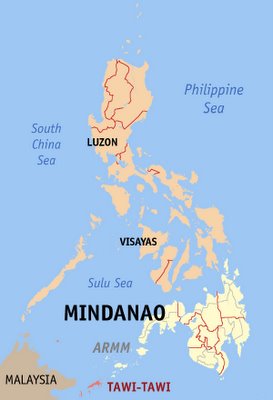 (Photo source.)
(Photo source.) Surely this remoteness has contributed to its lack of development. The province has many woes: electricity (delivered by desiel-fueled power barges) is said to be the most expensive in the country. Its fragmented landmass needs to be linked by a system of bridges. Water sources are few and hard to pump; given its island structure, saltwater intrusion can hardly be avoided.
However it has several things going for it. First, its remoteness from mainland Southern Philippines also means proximity to Borneo. If you walk through the typical Tawi-Tawi marketplace you will see plenty of Malaysian and Indonesian products. Tawi-Tawi was a traditional center of trade between Borneo and Southern Philippines. Before it was conducted on a barter basis (so was the common impression), but these days the transactions are regularly for currency. To a large extent this cross-border trade is happening informally.
Second is its security. Contrary to popular belief, Tawi-Tawi is not a dangerous place. Locals tell me perhaps that insecurity is true for nearby Sulu (which lies in-between Tawi-Tawi and the mainland) but not for Tawi-Tawi. A lot of it has to do with culture, apparently - not warlike, but peace-loving. They are more apt to trust the local military and police, and more suspicious of potential insurgents, or terrorists, or plain criminals, which have made Mindanao undeservedly notorious. (So perhaps there is a cultural basis for social capital?)
Third, its island structure is both a blessing and curse. I saw lots of beautiful sandy beaches (unfortunately I had no time to take a dip). Seaweed culture, as well as fishing, are major industries.
I spoke to some members of the local chamber of commerce. All of them complained against the high cost of doing business in the province. This is partly due to the unecessary bureaucracy, plus fees and paperwork, introduced by the national government and by the autonomous region of muslim mindanao (ARMM). For instance, the national government slaps a 1,620 pesos travel tax (about US$ 31.00) for every legal visit to Malaysia.
To a man and woman - lots of female entrepreneurship in this Muslim-dominated province - they all spoke of Tawi-Tawi's strategic location and wonderful economic potential. I broached the idea of a Tawi-Tawi freeport zone. Turns out, they had been proposing that for a long time. But the remote center (i.e. Manila - now I'm beginning to feel the long arms of Imperial Manila) has been cool to it.
For a special economic zone to work, a lot of infrastructure investments have to be put in place. But I think it makes a lot of sense - the idea certainly merits serious benefit-cost analysis. And government has to strike a deal with the local traders - we'll give you duty-free priveleges, and all the infrastructure to becoming a regional center of trade, but everything has got to be formalized, and all the requisite taxes on sales and income (minus absurd fees and charges such as the travel tax) will have to be collected. I don't see a reason for local entrepreneurs to object.
A thriving economic zone anchored on the freeport. Then sit back and enjoy watching this blessed province rocket ahead in the human development rankings.
4 comments:
I gather that a conversation with a barber from Tawi-Tawi will be different from the one you've just recounted in a previous post. Here's wishing more power to the idea of free trade and less to administrative overhead and 'imperial Manila'.
First, consider yourself fortunate. Many of us from Mindanao have not set foot on the faraway islands of Tawi-Tawi.
However, in that same trip did you not inquire and learn of the then thriving "barter" trade based in Zamboanga and resourced by traders coming from the islands south of Mindanao, including I suppose Tawi-Tawi?
During those times, I recall many shipping lines plying the Zamboanga-Visayas routes because merchants specifically from Cebu were making regular trips to replenish their inventory. Using what we then called "smuggled" goods.
CVJ,
Actually, I spoke to members of the local chamber of commerce. Yes, I wish people would start to get the idea of subsidiarity. Even though I do live in imperial Manila.
Amadeo,
An opportunity afforded me by work (a UNICEF-funded study on the Millenium Development Goals at the provincial level.)
The barter trade is the inspiration for the idea of the freeport. Barter was the traditional way of doing it, but now paper money is the more common way of doing it (the usual difficulties of barter, you know).
By way of clarification, the Zambo barter trade I was referring to was the one that flourished less than 30 years ago. And it was every bit a misnomer because for all intents and purposes, they were nothing more than merchants gathered together in one place and selling smuggled goods. I suppose it was the government’s way then of legitimizing and legalizing rampant smuggling activities through the backdoors that it couldn’t curb anyway. One doubts if taxes ever got collected.
But people could go to those places and purchase goods available which range from dry goods, food items like sotanghon, and small consumer electronics.
From stories reaching us, big-time storeowners from Cebu would send scores of their sales ladies by boat and financed by them, would purchase goods for resale in the merchant’s storefronts in Cebu.
Currently, the venues have changed. Now, I can surmise that smuggled goods most rampant of which are pirated items and fake brands, but there are other items, are sold either inside malls or around them in many cities in Mindanao, and one would be Cagayan de Oro.
Post a Comment